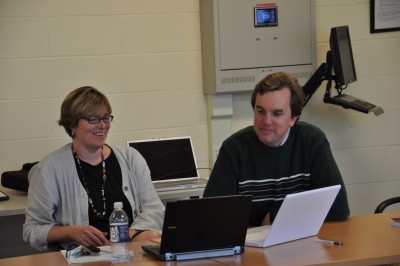
A major challenge is on its way to American education, one that teachers candidly concede they may not be ready to meet. Figures from the Census Bureau show that by 2030, 40% of U.S. students will be raised in homes where English is not the first language. Those startling numbers become even more of a concern when viewed alongside the results of a 1999 National Center for Education Statistics report that showed a vast majority of the teachers surveyed felt inadequately prepared to help English Language Learners (ELLs) succeed in the classroom. Teacher preparation programs, therefore, will have to focus more attention on getting pre-service teachers ready for the burgeoning ELL challenge they will face, and a new program at the Neag School aims to do exactly that.
Called Project PREPARE-ELLs (Preparing Responsive Educators to Promote Access and Realize Excellence with English Language Learners), the program grew out of a book club led by faculty members in the Neag School’s Bilingual and Multicultural Education Program. From 2006 to 2008, participation in the book club helped five professors begin understanding the needs that ELLs bring to their learning of academic content.
This year, the project expanded to include 16 faculty members and, with funding from the Neag Teachers for a New Era program, was able to bring nationally recognized ELL experts to the Storrs campus for an intensive week of professional development. Those 16 are now infusing the new materials, objectives and readings they were given into their own teacher preparation courses for students at the Neag School.
What are the problems that English Language Learners face? As Neag Assistant Professor Elizabeth Howard puts it, they are variable by age and educational experience, but, she adds, “ELLs also come with a host of interests, experiences and skills in their home languages that can be used to promote learning here.”
Too often, though, pre-service teachers have received what Howard calls “limited guidance” in the instruction of ELLs, and that guidance often comes too late in their training, well after their involvement in both methods courses and student teaching. Project PREPARE-ELLs is working with the Neag School’s IB/M and TCPCG faculty to assess the possibility of introducing diversity- and ELL-related course work earlier in those programs. They will be guided, in part, by the Sheltered Instructional Observational Protocol (SIOP), a research-based approach that provides ELLs with both language and content instruction simultaneously.
“It uses a lot of visual aids and manipulatives,” Howard says. “Another important component is comprehensible input; that is, slower, simplified speech that is frequently accompanied by graphic organizers and other teaching aids.”
But Project PREPARE-ELLs has only just begun its work and during the current academic year will continue to collect multiple forms of data to explore how revised curriculum and instruction are affecting both the Neag School’s teacher preparation courses and students’ knowledge, dispositions and teaching practices. As Neag Assistant Professor Thomas Levine views the Project’s goals and outcomes, they are designed, he says, “to achieve lasting, systemic change in the way individual instructors and our wider teacher preparation programs prepare teachers for culturally and linguistically diverse students.”
 Facebook
Facebook
 Twitter
Twitter
 LinkedIn
LinkedIn
